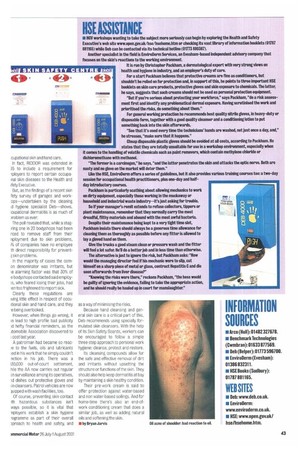It's a minefield out there for mechanics; nasty chemicals ready
Page 42

Page 43

If you've noticed an error in this article please click here to report it so we can fix it.
to attack the skin and leave a trail of dermatological disorders in their wake. The way to avoid them is to know the risk and your duty of care, and to make sure your fitters follow advice and use the equipment provided.
n a normal working day, fitters and technicians come into contact with all manner of substances, ranging from mildly irritant to fairly toxic, but given half a chance they'll go to work on your skin.
The most common culprits for causing harm are engine and hydraulic oils, grease, abrasives, chemicals, raw solvents and refinishing products such as paints and resins.
They're all capable of attacking an automotive worker's hands, and those with susceptible skin may well develop occupational dermatitis.
This painful condition is a serious problem on a national scale. It is a major cause of worker illness and is currently costing UK employers up to £20m a year in sickness absence and retraining costs, The seriousness of the condition varies, according to the amount of exposure to a particular irritant and the fitter's general susceptibility, but early signs are redness, itching and irritation. Blisters may follow and, if they break, infection usually sets in.
It is generally the hands or forearms that are the worst affected, but it can spread to other parts of the body. Without proper treatment, it can lead to long-term disabilities, as the skin's ability to heal itself diminishes.
In recent years, employers have come under increasing pressure to exercise a duty of care and to take employee welfare into greater consideration. Indeed, they're legally obliged to provide a safe working environment and to carry out regular assessments.
Duty of care obligations arise from the Health and Safety at Work Act of 1974 via a number of regulations. They include the Control of Substances Hazardous to Health (COSHH) 1994, Reporting of Injuries, Diseases and Dangerous Occurrences at Work ( RIDDOR) 1995 and Management of Health and Safety at Work Regulations 1992. All of these laws can all be related to cupational skin and hand care.
In fact, RIDDOR was extended in 35 to include a requirement for iployers to report certain °coupemai skin diseases to the Health and ifety Executive.
But, as the findings of a recent skin fety survey of garages and work ops—undertaken by the cleaning id hygiene specialist Deb—shows, ieupational dermatitis is as much of roblem as ever.
The poll revealed that, while a stag!ring one in 20 bodyshops had been
reed to remove staff from their nployment due to skin problems, N of companies have no employee th direct responsibility for preventskin problems.
In the majority of cases the carrion denominator was irritants, but alarming factor was that 30% of e bodyshops contacted said employ is, who feared losing their jobs, had :en too frightened to report sick. Clearly these regulations are wing little effect in respect of occuqional skin and hand care, and they :e being overlooked.
However, when things go wrong, it in lead to high profile bad publicity id hefty financial reminders, as the Jtomobile Association discovered to cost last year.
A patrolman had became so reac/e to the fuels, oils and lubricants
;ed in his work that he simply couldn't notion in his job. There was a 130,000 out-of-court settlement, hile the AA now carries out regular in surveillance among its operatives, id dishes out protective gloves and ;in cleansers. Patrol vehicles are now luipped with wash facilities, too.
Of course, preventing skin contact ith hazardous substances isn't
ways possible, SD it is vital that inployers establish a skin hygiene -ogramme as part of their overall 3proach to health and safety, and
as away of minimising the risks.
Because hand cleansing and general skin care is a critical part of this, Deb recommends using specially formulated skin cleansers. With the help of its Skin Safety Boards, workers can be encouraged to follow a simple three-step approach to personal work hygiene: cleanse, protect and restore.
Its cleansing compounds allow for the safe and effective removal of dirt and irritants without upsetting the structure or functions of the skin. They should also help keep dermatitis at bay by maintaining a skin healthy condition.
Their pre-work cream is said to offer protection against water-based and non water-based soilings. And for home-time there's also an end-ofwork conditioning cream that does a similar job, as well as adding natural oils and softening the skin.
• by Bryan Jarvis




















































































































